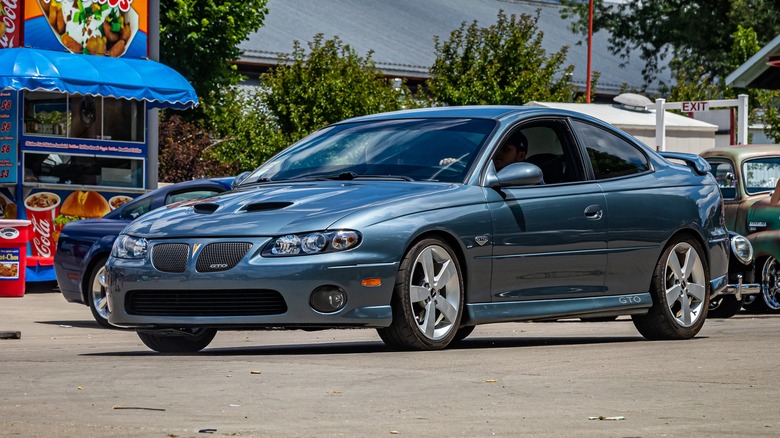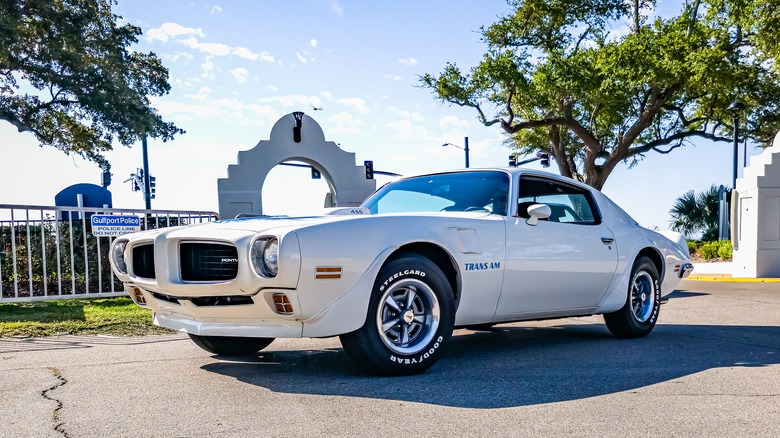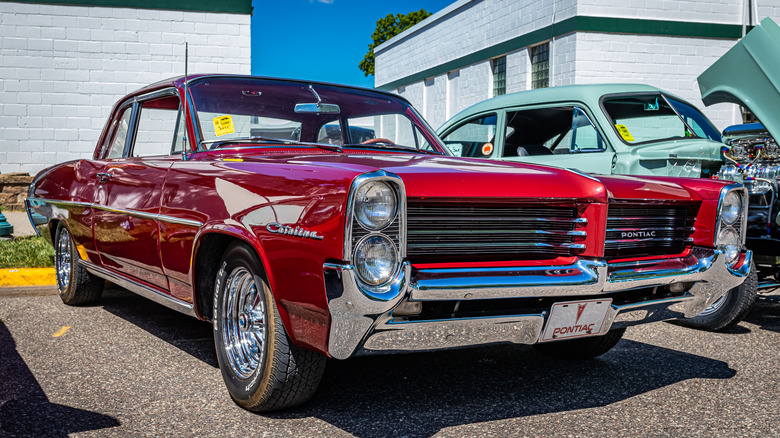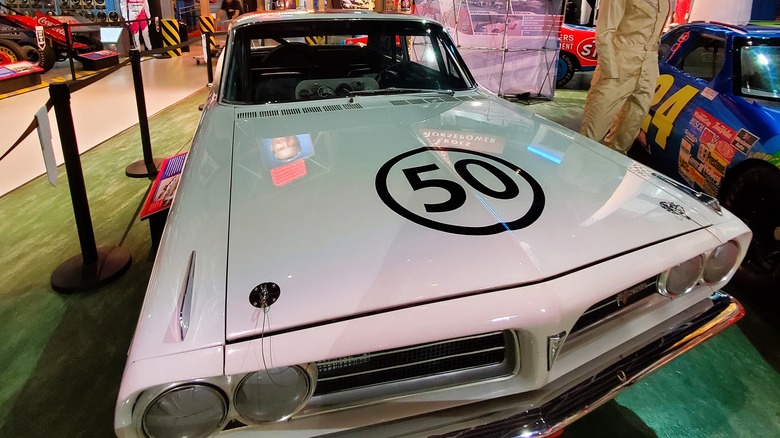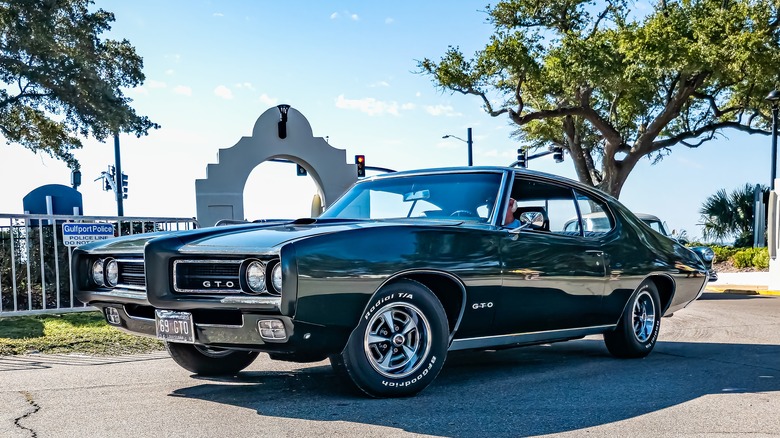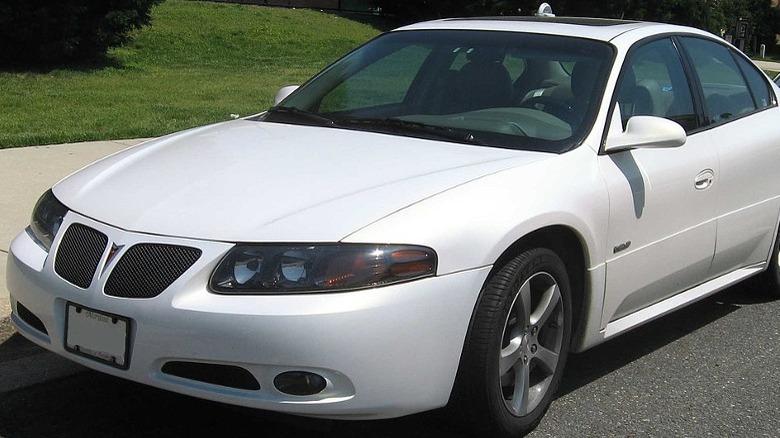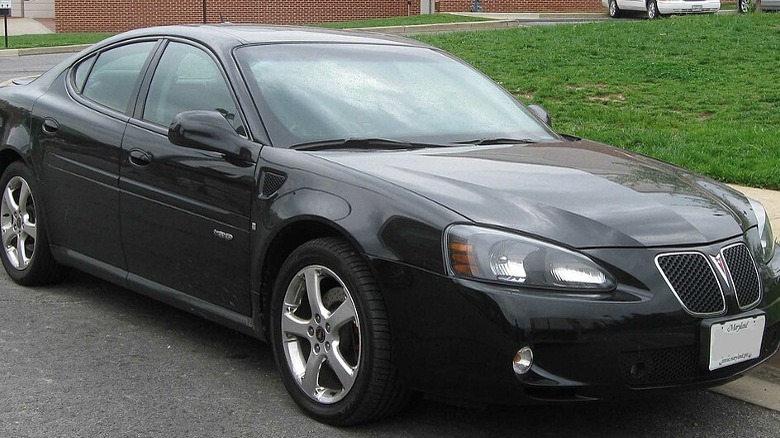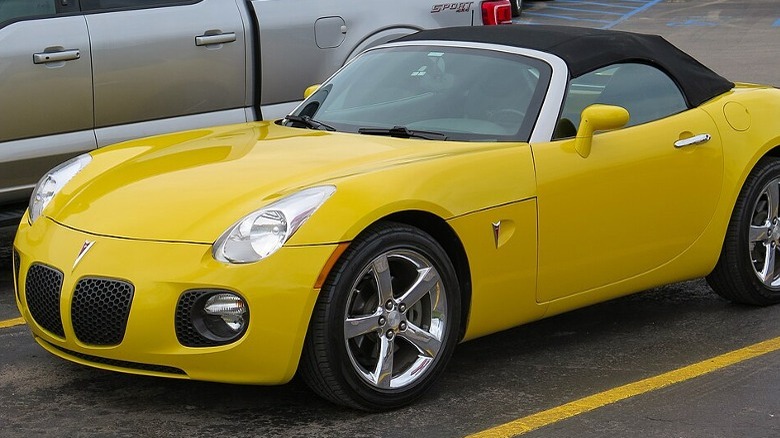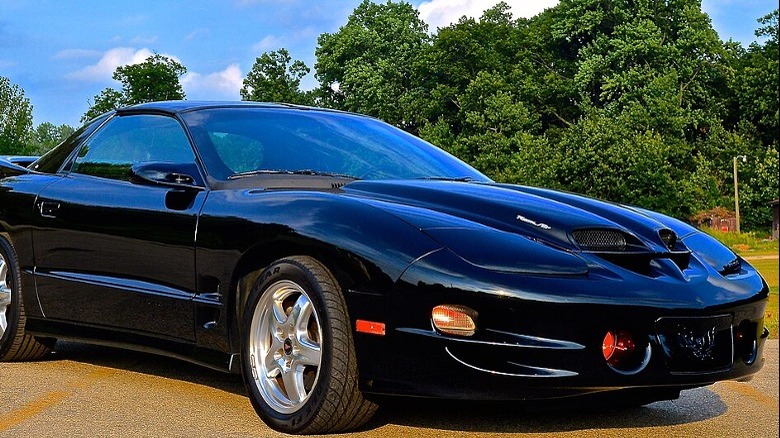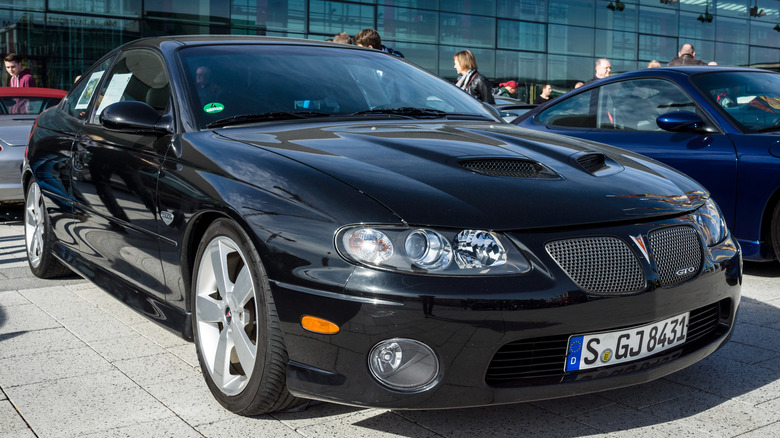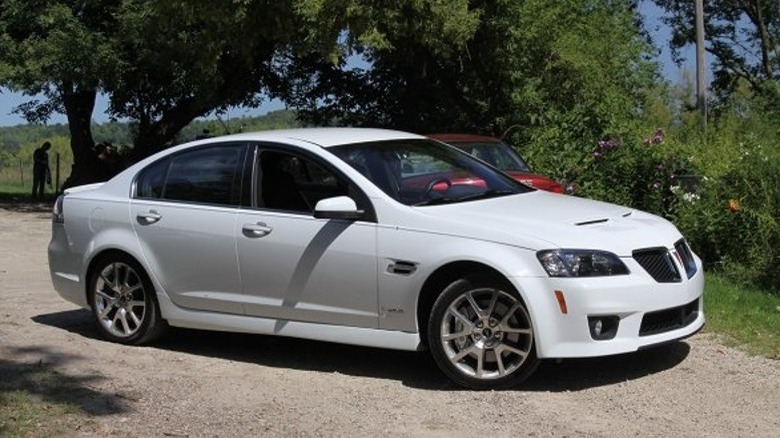11 Of The Fastest Pontiac Cars Ever Made, Ranked By Top Speed
Pontiac is a brand that is known for its iconic muscle cars but the automobile brand was also responsible for a wide array of vehicles. These ranged from sporty roadsters to coupes and sedans, combining performance with comfort. From the 1920s to the brand's end in 2010, Pontiac was a well-respected and famous name in the U.S. car market.
Although it is not a brand particularly known for fast cars, a number of Pontiacs have shown an impressive turn of speed. Whether it's the company's muscle cars that have an impressive rate of acceleration or sporty sedans that can set a respectable quarter mile time, there are some pretty speedy Pontiacs. However, these are just two of the ways to judge how fast a car actually is. You can also look at the terminal velocity of a vehicle to get an understanding of just how quickly it is capable of getting from one place to the next.
Here, we are going to examine the fastest Pontiac cars ever made, ranked by their top speed. We've based the information on official specifications released by Pontiac, reviews of cars, and data taken from trusted sources.
1973 Pontiac Firebird Trans Am 455 Super Duty (104 mph)
Among Pontiacs many different car lines, the Pontiac Firebird is arguably one of the most famous and beloved. One of several cool American pony cars, the Firebird was launched in 1967 in response to the Ford Mustang, which had been introduced to motorists three years earlier. It saw immediate competition not just with the Mustang, but also the recently released Chevrolet Camaro. It proved successful enough to last up to 2002, when the final Firebird hit the road.
The 1973 Pontiac Firebird Trans Am SD-455 was a limited edition version of the vehicle that included several modifications to increase the strength of the chassis. Yet, the manufacturer had faced pressures before the release of the car, such as an increased insurance rate for drivers using muscle cars and legislation in the form of the Clean Air Act that aimed to cut down on emissions by limiting vehicle performance and reducing the amount of fuel consumed.
That led to several muscle cars being dropped during this era, but Pontiac went ahead with a car that boasts more than 300 horsepower and is officially the fastest Pontiac Firebird ever created. Tests performed in 1973 revealed that it could cross the quarter-mile mark in under 14 seconds and could reach 103.56 mph with a full tank of gas and a stock automatic transmission, making it a truly memorable car. It also helped that the Trans Am 455 Super Duty also looked great.
1965 Pontiac 2+2 (115 to 125 mph)
Based on the earlier Pontiac Catalina model, the Pontiac 2+2 is a full-size car — also known as an executive or large car — first released to the public in 1964. The first model was essentially a variant of the Pontiac Catalina but this changed in 1965 when the manufacturer introduced the Pontiac 2+2 as a standalone product and no longer featured the name of the other car in its branding. The vehicle is a stylish two-door coupe that was in production until 1967, and is available as a hardtop or convertible.
Powering the Pontiac 2+2 is a 6.9 liter V8 engine that was capable of producing 338 horsepower, although there were also variants that included modified engines and intake manifolds that increased the horsepower to between 356 and 376. It also included strengthened springs and shock absorbers and the option of a manual or automatic transmission. Unfortunately for Pontiac, the 2+2 wasn't a huge success, and only 28,000 were built and sold during its production run.
The number of variants of the Pontiac 2+2 mean that it is hard to decipher its top speed. The most powerful version of the car was able to reach a top speed of 125 mph and accelerate from zero to 60 mph in around 7 seconds. Standard models appear to have been limited to just 115 mph, though it could reach a speed of 95 mph over a quarter mile.
1963 Pontiac Tempest Super Duty (123 mph)
The Pontiac Tempest came to be in an era when American manufacturers were attempting to develop compact cars to stave off competition from European brands such as Volkswagen who had introduced compact cars to the U.S. market. What helped the Pontiac Tempest stand out from other similar vehicles, such as the Chevy II and the Buick Special, was the fact that it had a distinctive drivetrain under the direction of noted car designer John DeLorean — the namesake of the DeLorean from the "Back to the Future" trilogy.
Not wanting to simply rebadge a Chevrolet Corvair as bosses at General Motors had suggested, DeLorean worked to create a comfortable and unique vehicle that could easily carry six adults. He achieved this by using an innovative drivetrain that involved a flexible driveshaft and a rear-mounted transaxle. The 1963 Super Duty version of the car was an incredibly limited run that saw only around a dozen models produced and replaced the standard four-cylinder engine with a 6.9-liter V8 that could produce 405 horsepower.
Combined with some extreme weight-saving measures that saw a large amount of material taken out of the car and certain elements being replaced with aluminum. Easily able to get over the 115 mph mark in around 12 seconds, the top speed for a 1963 Pontiac Tempest Super Duty was recorded at 123.11 mph.
1969 Pontiac GTO Judge (130 mph)
In many ways, the Pontiac GTO — nicknamed the Judge — was responsible for popularizing the very concept of the muscle car. Launched in 1963, the vehicle was initially an option package for the Pontiac LeMans, costing a few hundred dollars to upgrade it to Grand Turismo specification. After several years of selling this version of the car, which had a top speed of around 115 mph, Pontiac introduced a new version of the vehicle in the form of the 1969 GTO under the name "The Judge."
Inspired by the sketch comedy television series "Rowan & Martin's Laugh-In," the car was intended to compete with the Plymouth Road Runner, but cost significantly more. That might be why it only went on to sell just over 11,000 units across its lifetime. With a similar look to its predecessors, The Judge also featured a spoiler and a four-speed manual transmission. This deviated significantly from Pontiac's original plan to create a basic car that would be inexpensive to produce.
Utilizing a Ram Air III V8 engine, the 1969 Pontiac GTO Judge produced a maximum of 366 horsepower. That allowed it to travel across a quarter mile in less than 15 seconds and reach 60 mph in exactly six seconds. It could reach a maximum terminal speed of a little over 130 mph, a respectable speed for that period.
2004 Pontiac Bonneville GXP (138 mph)
Pontiac's rich history in racing during its early years, with David Abbott Jenkins breaking numerous speed records on the Bonneville Salt Flats, led to the company naming an entire line of cars after the location. The 1957 Pontiac Starliner Bonneville was an iconic car but was produced in low numbers, with just 630 models manufactured during its initial run. The success and popularity of the vehicle inspired Pontiac to create the next variant in higher numbers and the 1958 Pontiac Bonneville started a line of cars that would last up until 2005.
While the 10th generation of Pontiac Bonneville is not among the best, there's little doubt that it was the fastest. The 2004 Pontiac Bonneville GXP was one of the last models of the range and saw the company return the car to its sporty roots, with tight handling, aerodynamic exterior features, and responsive braking.
The 2004 variant is equipped with a 4.6 liter Northstar V8 engine, outputting 275 horsepower. That's enough to get the car up to a top speed of 138 mph, comparable with other sedans of the day. It also performed respectively when it comes to acceleration, able to reach 60 mph from a standing start in under seven seconds and travelling a quarter mile in 14.8 seconds.
2005 Pontiac Grand Prix GXP (143 mph)
Like much of Pontiac's lineup, the Grand Prix was part of a range that spanned several generations across four decades. The first entry arrived in 1962 initially as a series of coupes, before the brand switched the name to four-door sedans from the early 1990s through to the late 2000s. This led to the Grand Prix range taking on sportier characteristics and improved performance rather than focusing entirely on luxury.
The 2005 Pontiac Grand Prix GXP arrived at a point when the Pontiac brand was beginning to falter, meaning it was one of the last versions of the Grand Prix that were produced before General Motors discontinued the brand. A front-wheel drive vehicle, it was largely praised by critics and is known for its excellent reliability, making it popular in the used market.
This car certainly had plenty of power. Like its predecessors from the 1980s, it had a V8 engine in the form of a General Motors LS-based small-block powertrain. This provided a little over 300 horsepower, enough to propel the car at speeds of up to 143 mph. However, this terminal speed was limited by a governor, meaning that it could theoretically go even faster. The 2005 Pontiac Grand Prix GXP is also capable of reaching 60 mph in 5.7 seconds and completing a quarter mile in 14.3 seconds.
2007 Pontiac Solstice GXP (155 mph)
The Solstice is one of Pontiac's models that deserves more recognition. It was first introduced in 2006 to consumers after the original concept was shown several years earlier at the start of the 2000s. However, the fact came right at the time when the Pontiac brand was going through something of a slump and General Motors was about to drop the brand completely in favor of its core businesses means that it has been somewhat forgotten.
That's a shame because the Pontiac Solstice was not just a hit with critics but also with drivers, largely due to its stylish looks and great performance. Available as a two door coupe and a convertible roadster, the Pontiac Solstice was so in demand that General Motors had to apologize to many customers who ordered the vehicle but wouldn't receive it due to production delays.
2007 saw Pontiac create a special GXP version of the vehicle. This had an upgraded engine with a 2 liter capacity and a turbocharger, allowing it to produce up to 260 horsepower. That was enough power to get the 3,000 pound car up to a respectable 155 mph and accelerate from 0 up to 60 mph in a little over five seconds.
1998 Pontiac Firebird Trans Am (160 mph)
The Trans Am variant of the Pontiac Firebird was an optional package that was available for the standard car, adding a number of performance upgrades. These typically involved improving the suspension and handling of the vehicle, as well as increasing the power through engines that could produce extra horsepower. The 1998 variant is no exception to this rule, with the rear-wheel drive convertible and hardtop coupe being redesigned to incorporate the 5.7 liter LS1 V8 engine, rather than the previous standard V8 that had been used.
With the 1998 Pontiac Firebird Trans Am engine change came a raft of visual modifications. The car features a brand new hood, along with updated fenders and lights — which included popup headlights and honeycomb design for the taillights. As a safety measure, the car is fitted with a camel mode for the engine, which effectively shuts down half of the cylinders that are then used to pump air to cool the car in the event of a coolant leak. The aim of this was to give drivers the opportunity to slowly make their way to a garage without having to be towed.
The V8 engine in the 1998 Pontiac Firebird Trans Am could output 305 horsepower, giving the car a top speed of 160 mph and can get to 60 mph from a standing start in 5.5 seconds.
2002 Pontiac Firebird Trans Am WS6 (162 mph)
What made the Firebird Trans Am models of the classic Pontiac car so spectacular is that they often came with some striking visual changes, making them hugely desirable to anyone who wanted to look good while driving. In fact, the Trans Am models became so distinctive that they became an iconic part of popular culture through appearances in shows such as "Smokey and the Bandit" and "Knight Rider," where the car was used for the futuristic KITT.
2002 Pontiac Firebird Trans Am WS6 proved to be the final release of not only the Trans Am models but the entire Firebird range. This particular variant can't exactly be blamed for that demise of the line, as the car was imposing from both a performance and visual standpoint. What really spelled the end of the Firebird, along with another General Motors mainstay the Chevrolet Camaro, was upcoming regulatory changes that meant the vehicles would have to be completely redesigned — something that didn't make a whole lot of sense financially given diminishing sales for this type of vehicle.
Equipped with a 5.7 liter LS1 V8 engine, the 2002 model could produce 325 mph, allowing it to go from 0 to 60 mph in under five seconds. Perhaps more spectacular is its quarter mile time of 13.5 seconds and top speed of 162 mph. Those with the funds and time to mod the Firebird can easily take the car to even faster speeds.
2006 Pontiac GTO (170 mph)
The 2006 Pontiac GTO is a continuation of a line that began way back in 1963. However, Pontiac dropped the range in 1974 before it was revived in the early 200s, this time with Holden taking up design and manufacturing duties but using the Pontiac name and brand in the U.S. The car is essentially a Holden Monaro that has been rebadged, a car that had found plenty of success in Australia but struggled in the American market due to a high price and a dated design. That might explain why it was only available in a smaller number of models up until 2006, with sluggish sales meaning that importing the car became financially unviable.
Compared to the classic 1969 Pontiac GTO Judge model, which clocked in at 366 horsepower, the 2006 version of the car is notably more powerful. The 6 liter LS2 V8 engine packs a punch and is one of the most powerful engines in any Pontiac car ever built. Along with 400 lb-ft of torque, the 2006 Pontiac GTO is able to produce a maximum of 400 horsepower. That means that the vehicle can get from 0 to 60 mph in under five seconds and complete a quarter mile in 13.3 seconds. Among those impressive stats, the car has a top speed of 170 mph.
2009 Pontiac G8 GXP (185 mph)
Out of all of the cars that Pontiac has produced over its long history, the Pontiac G8 is one of the most short-lived. Introduced in 2008, the car is in the unique position of not being developed or designed by Pontiac but rather an Australian subsidiary of General motors known as Holden. Largely based on the previous Holden Commodore, just under 40,000 versions of the G8 were created.
The Pontiac G8 was already firmly established as a fast car with good performance. The earlier G8 GT model was able to achieve over 360 horsepower with a 6 liter V8. However, the 2009 Pontiac G8 GXP was upgraded significantly so that it could go even faster. This car is powered by a 6.2 liter LS3 V8 engine, with up to 415 horsepower at peak performance. Available in both automatic and manual transmission, with a six-speed gearbox, it is the Pontiac of choice for those who want to get somewhere fast.
That's because it achieved a time of just 13.2 seconds across a quarter mile test, where it reached an impressive speed of 112 mph. In terms of top speed, the 2009 Pontiac G8 GXP can travel at a governor limited 185 mph. The car is also equally as impressive over short distances, able to get up to 60 mph from a standing start in only 4.5 seconds.
